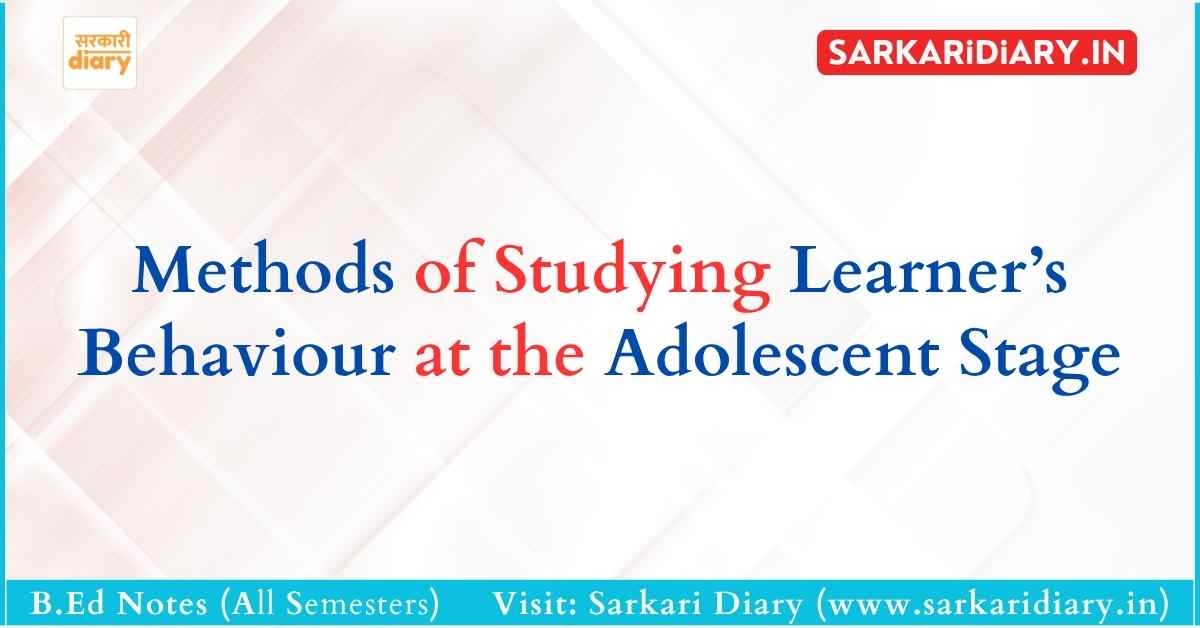Adolescence is a crucial period marked by significant cognitive, social, and emotional transformations. At this stage, learners develop abstract, logical, and idealistic thinking, enabling them to critically examine their own thoughts and those of others. According to Piaget’s theory, formal operational thought emerges between the ages of 11 and 15, where adolescents transcend concrete experiences to think abstractly and reason systematically.
Understanding adolescent behaviour requires appropriate research methods that can effectively capture their evolving cognitive and social awareness. This article explores key methods used to study adolescent behaviour, providing insights suitable for educators, psychologists, and researchers.

Cognitive Development in Adolescence
| Age Range | 11 to 15 years (formal operational stage) |
| Thinking Style | Abstract, logical, idealistic |
| Problem Solving | Systematic, hypothetical-deductive reasoning |
| Social Awareness | Increased ability to evaluate self and others against ideal standards |
Methods to Study Adolescent Behaviour
Several scientific methods are employed to study adolescent learners. These include Observation, Interview, Experimentation, and Case Study. Each method serves a distinct purpose and offers unique advantages and limitations.
Observation
Observation is a fundamental technique in psychological research, involving the systematic watching, recording, and analysis of behaviour.
| Selection | Focus on specific behaviours relevant to the study |
| Recording | Use of notes, tallies, shorthand, photographs, or videos |
| Analysis | Interpretation of recorded data to derive meaningful conclusions |
Types of Observation
| Type | Description | Example |
|---|---|---|
| Naturalistic Observation | Observing behaviour in a real-life setting without interference | Watching student interactions in a classroom |
| Controlled Observation | Observation in a controlled environment where some factors are regulated | Laboratory-based studies |
| Non-Participant Observation | Observer remains detached, without interacting with subjects | Sitting quietly at a distance in a classroom |
| Participant Observation | Observer actively participates in the group being studied | A teacher joining student activities to understand group dynamics |
Advantages:
- Captures authentic behaviour in natural settings.
- Provides rich qualitative data.
Challenges:
- Time-intensive and labour-heavy.
- Observer bias can affect results.
- Requires skillful execution.
Interview
Interviews facilitate direct communication between the researcher and adolescent learners to gather in-depth personal information.
| Interview Type | Description |
|---|---|
| Unstructured | Free-flowing conversation, flexible questioning, fosters open expression |
| Structured | Pre-determined set of questions asked uniformly to all subjects |
Types of Interviews by Function and Participation
| Function | Individual | Group |
|---|---|---|
| Diagnostic | ✔ | ✔ |
| Clinical | ✔ | ✔ |
| Research | ✔ | ✔ |
| Role Type | Description |
|---|---|
| Non-directive | Interviewer guides minimally |
| Focused | Targeted questions on specific issues |
| Depth | In-depth exploration of particular topics |
Key Steps in Interview Process
| Step | Description |
|---|---|
| Preparation and Rapport | Establishing trust and comfort with the adolescent |
| Problem Unfolding | Discussing the core issues |
| Joint Problem Solving | Collaboratively exploring solutions |
| Closing | Ending the interview on a positive note |
| Evaluation | Reviewing interview effectiveness |
| Follow-up | Conducting subsequent sessions if needed |
Advantages:
- High reliability of information.
- Can uncover confidential and unconscious data.
Disadvantages:
- Time-consuming and costly.
- Requires skilled interviewers.
- Risk of bias or reluctance from interviewees.
Experimentation
Experimentation involves a controlled procedure where one variable is manipulated to observe its effect on another, establishing cause-effect relationships.
| Variable Type | Description |
|---|---|
| Independent Variable | Factor manipulated by the researcher |
| Dependent Variable | Outcome measured, affected by manipulation |
Example: Testing how different classroom environments affect adolescent exam performance.
Case Study
Case studies focus on a detailed, in-depth analysis of an individual adolescent or a specific group.
| Characteristics | Description |
|---|---|
| Uses multiple data collection methods: interviews, observation, psychological tests | Enables comprehensive understanding |
| Provides detailed narratives of experiences, behaviours, and emotions | Rich qualitative data |
| Challenges include difficulty in generalising findings | Validity depends on data from multiple sources |
Summary Table: Methods to Study Adolescent Behaviour
| Method | Description | Advantages | Limitations |
|---|---|---|---|
| Observation | Watching behaviour in natural or controlled settings | Realistic data; non-intrusive | Time-consuming; observer bias |
| Interview | Face-to-face personal communication | In-depth info; confidentiality possible | Expensive; needs skilled interviewer |
| Experimentation | Controlled manipulation of variables | Establishes causality | Artificial setting; ethical considerations |
| Case Study | Detailed study of individual/group | Rich, contextual insights | Limited generalisability; resource-intensive |
Conclusion
Studying adolescent behaviour requires a multi-method approach to capture the complexities of this developmental stage. Understanding the strengths and limitations of each method helps educators, psychologists, and researchers to select appropriate tools for effective study and intervention. Combining observation, interviews, experimentation, and case studies ensures a holistic insight into adolescent cognitive, social, emotional, and moral growth.